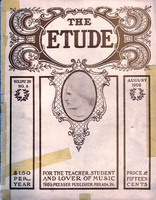Instrumental fugal music is caviare to the average recital-goer; trite enough a fact, in all conscience. The following arty (sic?) definition reminds us—the latter part especially—that “many a true word is spoken in jest.” “In a fugue the parts run away from each other, and the listeners run away from the lot.” Why is this?
When we find how appreciated choral fugues are, it is, to a certain extent, difficult to account for. Yet we need not go far to seek a part explanation. Many of the more elaborate fugues of Bach, Merkel, Rheinberger, and other classical writers are not even ordinarily interesting to, and appreciated by, organists themselves at one hearing; indeed, many immortal works in this form—for fugues will assuredly live, notwithstanding modern and ultramodern tendencies and developments—can only be understood and adequately appreciated by continued study. How, then, can it rationally be expected that the general public care for fugues? As organists have to be educated, so must the public.
Further, for the state of affairs to which allusion has been made organists must be prepared to accept a share of the responsibility. Religiously to include a Bach item in each recital program, because it is conventional so to do, is not sufficient. Who will deny that Bach would become a more widely known and popular composer with the masses if his compositions were played, not so much as regards the method of treatment (though this is no unimportant factor), as in a certain progressive order? (And, of course, more organists need to study Bach.)
Methinks that organists are not really aware of their responsibilities and their true position in relation to the public. The possibilities arising out of influences exerted by them might be immense, and material assistance rendered toward bringing about a better and thorough understanding of all that pertains to our “divine art.” The musical tastes and inclinations of the public generally are, to a large extent, entirely in their hands. “The fugue,” as Schumann writes, “is the most profound of musical forms,” and must be popularized to be genuinely appreciated.
To educate the public mind in this as in other respects is the duty and privilege of organists, and sooner or later they will awaken to the fact.
Latterly I have spent some time studying fugues by Guilmant and Salome, two representative French composers for the “king of instruments.” Admiration for their works increases as they become more and more known. In them is found brilliant, yet withal solid, scholarly workmanship, attractive alike by their clarity and uniformly maintained interest, their ease, gracefulness, and naturalness, as against the lucubratory laborings we (too often) meet in this form. In fine, they at once bear the impress of musicianship.
Guilmant’s series of “Pieces in Different Styles for the Organ” (eighteen books) contains several interesting fugues (Sonatas, Nos. 3 and 6 have fugue movements; No. 5 contains a choral and fugue). Salome’s Fugue in B-flat (No. 6 of “Ten Pieces,” set 2) may also be recommended. While thus writing I might mention a few works of Bach which may well serve as introductory (in a progressive sense) to his more elaborate and profound creations. Fugue in E-minor, Fugue in D-major (“The Great,” volume I, Best’s edition); Fugue in A-minor, Prelude and Fugue in G-minor (volume II); Fantasia and Fugue in G-minor, Toccata and Fugue in D-minor (volume IV); Fantasia and Fugue in A-minor, Fugue in G, Fugue in G twelve-eight time (volume IX), which has not inaptly been designated by Mr. E. H. Lemare “Fugue à la Gigue,” presumably on account of its lively character; and also the Prelude and Fugue in D-minor and the Prelude and Fugue in B-flat of the “Eight Short” (shunned for recital purposes for no valid reasons).—E. Stanley Jones, in Musical Opinion.



